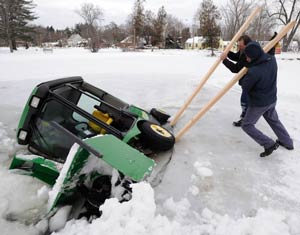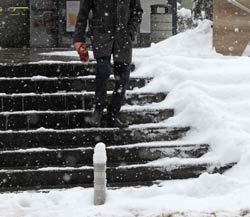
How to Manage Ice-related Risks
Winter presents several unique challenges in risk management for PDRMA members, but few are as tricky — and insidious — as ice hazards. “There are two major, open-water, ice-related hazards,” says Tim Jaskiewicz, PDRMA Risk Management Consultant. “Falling through the ice and slips trips and falls. We encourage members to take a conservative approach when determining the safety of frozen, open bodies of water.”
 Over the last couple years, PDRMA agencies have filed claims for vehicles falling through the ice on ponds or lakes. “We recommend using the lightest piece of equipment to accomplish the task when going onto open-water ice and not to bring heavy equipment on anything less than 15” of ice,” cautions Jaskiewicz. “Some equipment may require even thicker ice, depending on its weight." Over the last couple years, PDRMA agencies have filed claims for vehicles falling through the ice on ponds or lakes. “We recommend using the lightest piece of equipment to accomplish the task when going onto open-water ice and not to bring heavy equipment on anything less than 15” of ice,” cautions Jaskiewicz. “Some equipment may require even thicker ice, depending on its weight."
Be sure your agency also considers the following.
- Choose options other than vehicles to clear snow off the ice and maintain due diligence with ice inspections (Ice Skating Inspection Log).
- Take a conservative approach when determining whether the ice is thick enough to allow skaters on your ponds/lakes. Among factors to consider are the expected number of skaters, type of activity, freeze and thaws, and snow cover. Refer to the Ice Thickness and Safety Recommendations for Open Water Areas before making a final determination.
Woodridge Park District
 “I would have to say that slips, trips and falls are the most challenging ice risks in my experience,” says Blake A. McMahon, CPO, Parks Maintenance Operations Manager at Woodridge Park District. “That’s because they can happen at any given time to just about anyone, even with proper safety techniques and practices in place.” “I would have to say that slips, trips and falls are the most challenging ice risks in my experience,” says Blake A. McMahon, CPO, Parks Maintenance Operations Manager at Woodridge Park District. “That’s because they can happen at any given time to just about anyone, even with proper safety techniques and practices in place.”
According to McMahon, the agency handles this ever-present risk with safety equipment and diligence. “We have slip-on boot gripping devices that help provide better grip and traction in less-than-optimal weather conditions such as snow and ice,” he explains. For vehicle safety, they use high-visibility personal protective equipment (PPE) — parka jackets with class 2 and class 3 visibility strips, strobe work lights and back-up warning systems in plow vehicles.
McMahon advises fellow PDRMA members to invest, invest, invest. “Invest in good PPE and winter gear and invest in training programs through PDRMA and other resources. Check your equipment and be proactive with preventive maintenance and replacements as needed.”
McMahon also suggests taking full advantage of PDRMA’s Online Learning Center and in-house staff training and education on safety risk management techniques. “Training has been most helpful in being able to manage our ice-related risks.”
Hoffman Estates Park District
 “It’s important always to be aware of slip, trip and fall dangers. No matter how careful you are about removing snow and ice from agency parking lots, roadways, sidewalks or facility entrances,” observes Pete Cahill, Director of Administrative Services at Hoffman Estates Park District, “your employees and/or patrons will encounter slippery surfaces whether they are working outdoors or using our facilities” “It’s important always to be aware of slip, trip and fall dangers. No matter how careful you are about removing snow and ice from agency parking lots, roadways, sidewalks or facility entrances,” observes Pete Cahill, Director of Administrative Services at Hoffman Estates Park District, “your employees and/or patrons will encounter slippery surfaces whether they are working outdoors or using our facilities”
Cahill has found the best ways for the agency to reduce weather-related slip, trip and fall risks are to:
- Implement a safe winter walking and ice working procedure.
- Conduct employee training on safe winter walking and ice working.
- Have supervisory staff diligently enforce the safe winter walking and ice working procedure.
- Provide coaching and positive feedback on that procedure.
- Encourage peer-to-peer observation and feedback.
Whether your agency has frozen, open bodies of water or only “dry” land, ice is pervasive in winter, and so are the associated risks. Before the temperatures plummet, be sure your agency has a plan to keep employees, patrons — and vehicles — safe from icy dangers. |